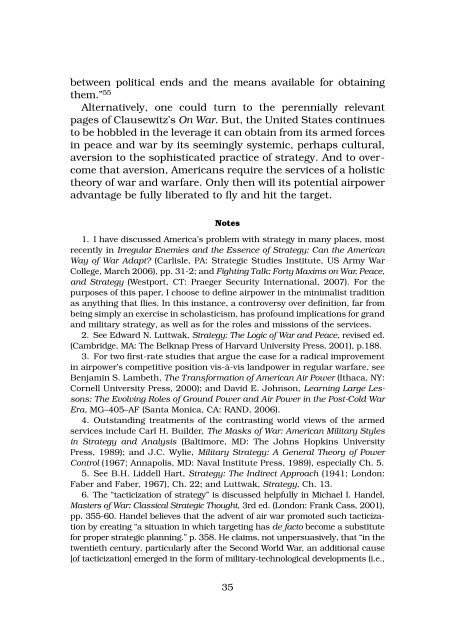The Airpower Advantage in Future Warfare
the Airpower Advantage in future Warfare - Air University Press
the Airpower Advantage in future Warfare - Air University Press
Create successful ePaper yourself
Turn your PDF publications into a flip-book with our unique Google optimized e-Paper software.
etween political ends and the means available for obta<strong>in</strong><strong>in</strong>g<br />
them.” 55<br />
Alternatively, one could turn to the perennially relevant<br />
pages of Clausewitz’s On War. But, the United States cont<strong>in</strong>ues<br />
to be hobbled <strong>in</strong> the leverage it can obta<strong>in</strong> from its armed forces<br />
<strong>in</strong> peace and war by its seem<strong>in</strong>gly systemic, perhaps cultural,<br />
aversion to the sophisticated practice of strategy. And to overcome<br />
that aversion, Americans require the services of a holistic<br />
theory of war and warfare. Only then will its potential airpower<br />
advantage be fully liberated to fly and hit the target.<br />
Notes<br />
1. I have discussed America’s problem with strategy <strong>in</strong> many places, most<br />
recently <strong>in</strong> Irregular Enemies and the Essence of Strategy: Can the American<br />
Way of War Adapt? (Carlisle, PA: Strategic Studies Institute, US Army War<br />
College, March 2006), pp. 31-2; and Fight<strong>in</strong>g Talk: Forty Maxims on War, Peace,<br />
and Strategy (Westport, CT: Praeger Security International, 2007). For the<br />
purposes of this paper, I choose to def<strong>in</strong>e airpower <strong>in</strong> the m<strong>in</strong>imalist tradition<br />
as anyth<strong>in</strong>g that flies. In this <strong>in</strong>stance, a controversy over def<strong>in</strong>ition, far from<br />
be<strong>in</strong>g simply an exercise <strong>in</strong> scholasticism, has profound implications for grand<br />
and military strategy, as well as for the roles and missions of the services.<br />
2. See Edward N. Luttwak, Strategy: <strong>The</strong> Logic of War and Peace, revised ed.<br />
(Cambridge, MA: <strong>The</strong> Belknap Press of Harvard University Press, 2001), p.188.<br />
3. For two first-rate studies that argue the case for a radical improvement<br />
<strong>in</strong> airpower’s competitive position vis-à-vis landpower <strong>in</strong> regular warfare, see<br />
Benjam<strong>in</strong> S. Lambeth, <strong>The</strong> Transformation of American Air Power (Ithaca, NY:<br />
Cornell University Press, 2000); and David E. Johnson, Learn<strong>in</strong>g Large Lessons:<br />
<strong>The</strong> Evolv<strong>in</strong>g Roles of Ground Power and Air Power <strong>in</strong> the Post-Cold War<br />
Era, MG–405–AF (Santa Monica, CA: RAND, 2006).<br />
4. Outstand<strong>in</strong>g treatments of the contrast<strong>in</strong>g world views of the armed<br />
services <strong>in</strong>clude Carl H. Builder, <strong>The</strong> Masks of War: American Military Styles<br />
<strong>in</strong> Strategy and Analysis (Baltimore, MD: <strong>The</strong> Johns Hopk<strong>in</strong>s University<br />
Press, 1989); and J.C. Wylie, Military Strategy: A General <strong>The</strong>ory of Power<br />
Control (1967; Annapolis, MD: Naval Institute Press, 1989), especially Ch. 5.<br />
5. See B.H. Liddell Hart, Strategy: <strong>The</strong> Indirect Approach (1941; London:<br />
Faber and Faber, 1967), Ch. 22; and Luttwak, Strategy, Ch. 13.<br />
6. <strong>The</strong> “tacticization of strategy” is discussed helpfully <strong>in</strong> Michael I. Handel,<br />
Masters of War: Classical Strategic Thought, 3rd ed. (London: Frank Cass, 2001),<br />
pp. 355-60. Handel believes that the advent of air war promoted such tacticization<br />
by creat<strong>in</strong>g “a situation <strong>in</strong> which target<strong>in</strong>g has de facto become a substitute<br />
for proper strategic plann<strong>in</strong>g.” p. 358. He claims, not unpersuasively, that “<strong>in</strong> the<br />
twentieth century, particularly after the Second World War, an additional cause<br />
[of tacticization] emerged <strong>in</strong> the form of military-technological developments (i.e.,<br />
35
















